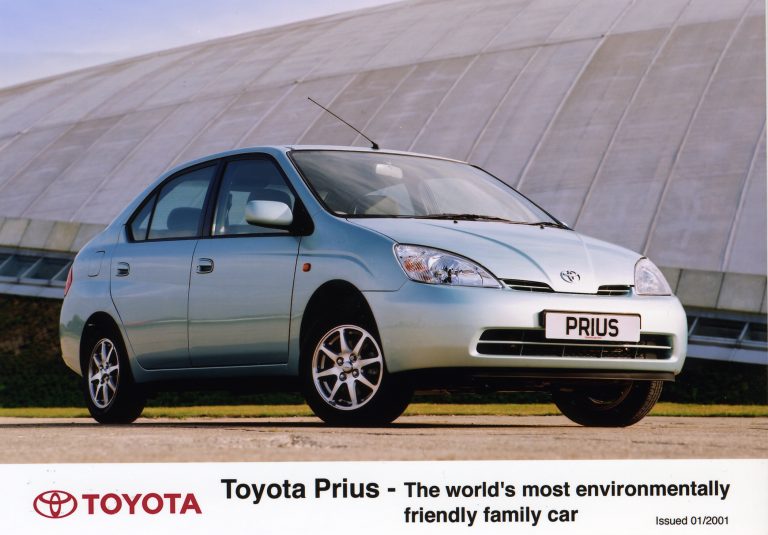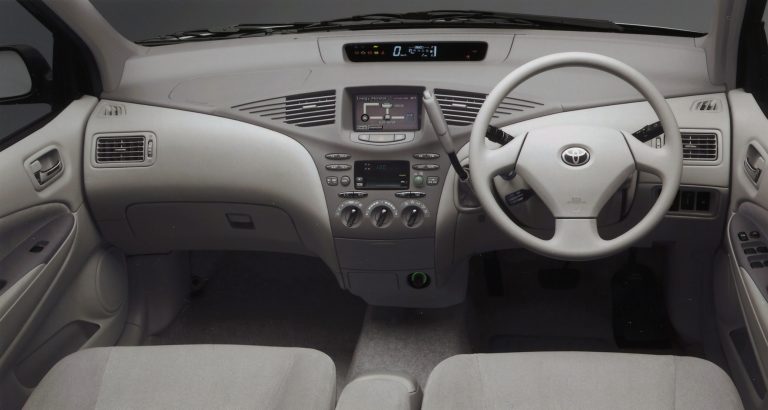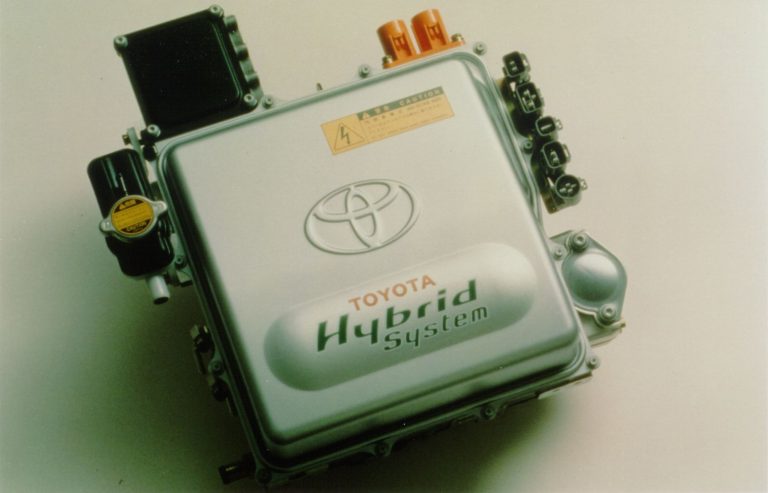Prius Comes to Europe
- First practical petrol-electric car to go on sale
- Low emissions, low fuel consumption
- Engineered for European driving style
- Comfortable, spacious and safe to drive
- Conventional refueling, long battery life
Toyota has confirmed it is planning to launch its revolutionary Prius hybrid-powered car in Europe next summer. A European specification Toyota Prius is being shown at the London Motor Show, revealing Toyota’s commitment to develop this remarkable new vehicle for the market.
Prius will also go on sale in North America during 2000.
The world’s first mass production hybrid vehicle, Toyota Prius is a breakthrough in practical, low emissions automotive technology. Powered by the Toyota Hybrid System (THS), Prius can run on either its highly efficient 1.5-litre petrol engine, its electric motor, or a combination of both. The ratio of power provided by each system is constantly monitored electronically, depending on speed and load, to keep the car in its most efficient operating mode.
Unlike the prototype low emissions vehicles displayed by other manufacturers, Prius is both a glimpse of the future and a practical family car for today.
It is a four-door, five-seater saloon, which drives and handles like a conventional car. It has full safety features, including anti-lock brakes and driver and passenger airbags, plus conventional comfort features such as electric windows, audio equipment, air conditioning and, optional, satellite navigation system.
ENGINEERED FOR EUROPE
For the European market, Toyota research engineers have set a target of less than 5.0 litres/100 kilometres on the combined European fuel cycle and carbon dioxide emissions of 120g/km.
The challenge for the engineers has been to achieve effective emission control and low fuel consumption in Europe while retaining the principal requirement of Prius that it should be no less comfortable and no more difficult to drive than a conventional petrol car with automatic transmission.
European driving conditions are considerably different from those in Japan. Cruising speeds are higher, traffic in cities is less congested, and country roads increase demands on ride and handling. The Hybrid System control software, transmission gearing and engine characteristics of Prius have all been adapted for European conditions.
Top speed, standing start acceleration and mid-range acceleration have all been improved.
SALES SUCCESS
The Toyota Prius went on sale in Japan in December 1997 and has already proved to be an outstanding sales success. Approximately 30,000 cars have been bought since then and production volumes have been increased to 1,500-2,000 a month.
Customer satisfaction is high. Owners give the car particularly high ratings for the hybrid system, interior space, its comfortable driving position, lack of road noise and vibration, and instrument layout.
Export volumes from Japan are estimated at 20,000 cars a year to both the North American and the European markets. Sales targets for individual European markets are still being analysed but the primary market will be in major European towns and cities where traffic congestion is high and environmental issues are a public concern.
Prius can be serviced routinely at a conventional Toyota dealership but potential customers are likely to require specialist sales support and finance packages. A full roadside recovery and support package is under development.
A REAL CAR
Prius was designed by Toyota’s Calty Design Research Inc. in California with a clear brief to develop a conventional modern saloon around a revolutionary power plant. It has a spacious interior, with long wheelbase within a short overall body length, and wide, easy entry through all four doors.
For the European market bumpers have been lowered, rear fog lamps added and front and rear spoilers fitted. These help to reduce the frontal drag coefficient thus further improving fuel consumption, performance and energy consumption.
Prius has a single, dashboard mounted gearshift lever commanding the THS which functions as a continuously variable transmission. Other steering column control stalks act as they would in a conventional car and the use of a foot operated parking brake creates a large walk-through area around the driver and front seat passenger.
Control of the Toyota Hybrid System is entrusted to its electronic control system and vehicle information is displayed in the 5.8 inch central monitor which shows energy status and recovery usage. It also serves as a general display panel for audio and, where fitted, navigation information.
HOW THE TOYOTA HYBRID SYSTEM WORKS
The Toyota Hybrid System (THS) is a carefully integrated package whose mechanical components take up little more space beneath the bonnet than a conventional engine. The unit consists of a specially developed, high efficiency, 1.5-litre petrol engine; a compact and high-torque electric drive motor; and a separate generator.
The power unit works in conjunction with a bank of advanced nickel-metal hydride batteries which form an energy buffer. Because they are maintained in a constant state of charge by the THS engine, they never need external recharging.
The various mechanical elements of the THS are connected by a power splitting device, in the form of an epicyclic gear train, which enables the engine output to be divided between driving the wheels and turning the generator. The key to the mechanical efficiency of THS is the electronic control of power flow between the mechanical and electrical elements to ensure that energy consumption is optimised at all times.
The main function of the petrol engine is to drive the wheels but any excess output is used to recharge the batteries. The batteries are also charged by regenerative braking. In turn, the batteries supply extra power, via the drive motor, when required such as for hill climbing or overtaking.
In particular situations where the petrol engine cannot run efficiently, or where it would produce relatively high emissions for example at low speed, travelling downhill or when standing still it is switched off altogether. Starting from rest is normally accomplished in electric drive only; the petrol engine starting as the Prius picks up speed.
Because the petrol engine operates under relatively stable load conditions, supported by the electric drive motor when necessary, it can be designed for maximum efficiency and minimum emissions.
WHOLE LIFE RECYCLING
Toyota Prius is designed to be less damaging to the environment throughout its life and the car has been manufactured with specific materials for maximum recyclability. These include extensive use of Toyota’s Super Olefin Polymer (TSOP) for many of the moulded interior and exterior fittings plus recycled soundproofing product (RSPP) made from automotive shredder residue.
The high technology nickel-metal hydride batteries used in Prius will last longer than batteries used in conventional electric vehicles and the battery bank is much smaller. Toyota will establish a network capable of collecting and recycling the batteries in all markets.
ON SALE
The Toyota Prius will go on sale across Europe from the summer of next year. It will be backed by a full Toyota warranty and after sales service.
Full details on Toyota (GB) PLC’s sales and marketing plans for the Prius will be released closer to launch date.
ENDS





